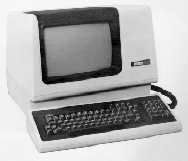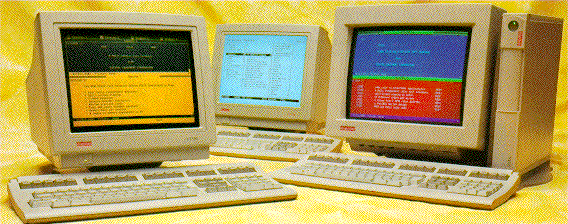 The DEC VT100
The DEC VT100
and its successors...

 The DEC VT100
The DEC VT100
and its successors...

Once upon a time (about A.D. 1957), a nice man named Ken Olsen and his friends set up a business in an old textile mill alongside the Assabet River in the small town of Maynard, Massachusetts. They named their company "Digital Equipment Corporation".
In those days, everybody knew that a COMPUTER was a gigantic complicated machine made by IBM, and to operate a COMPUTER, you had to have a staff of 100 engineers and programmers...not to mention all the keypunch operators who generated the stacks of 80-column punched cards on which were stored the programs and data. But Ken had studied engineering at MIT, and he had an idea for an easier way to do computing. Because he knew that a COMPUTER was a scary thing to his potential customers, Ken and his friends at DEC made up a new name for the machines they were making: "Programmed Data Processors", or PDPs. And, naturally, the first such machine was the PDP-1.
The PDP-1 had a cathode-ray-tube screen in its operator console, and that screen was the very first video-display device designed by Digital Equipment Corporation. The distinctive shape of that CRT display inspired the logo for the DECUS user group.
Subsequently, DEC introduced other display products, such as the VT05, a "glass Teletype". (According to the Small Computer Handbook, the VT05 did incorporate direct cursor addressing). A refined design appeared around 1974, in the form of the VT52. In the VT52's heyday, the best description of the video-terminal market was "The Tower of Babel": each manufacturer of terminals invented a proprietary set of terminal functions and codes (Escape sequences) to control the functions. But increasing programmer and user frustration with this state of affairs eventually led to the development of an ANSI standard for device control.
When ANSI's X3 Committee published the X3.64 document (in late 1977), some terminal vendors, insisting on using discrete logic designs, objected that the standard was so complex it could not be implemented. (Most of these vendors are now floating belly-up on the tide of technology.)
But DEC's implementation, the VT100, embodied the new idea of using a general-purpose microprocessor (an 8-bit Intel 8080) to interpret the control codes. And thus began a long line of successful ANSI-standard character-cell terminals sold by DEC. Although it was not the first video terminal to implement the ANSI X3.64 control standard, the VT100 enjoyed great popularity and soon became the most widely imitated asynchronous terminal.
All DEC terminals that came after the VT100 are able to emulate their ancestor, although they offer new features in addition to what the VT100 could do. Most modern so-called "VT100" emulations actually mimic the display capabilities of the slightly more capable VT102 and may even include keyboard controls that really were found only in later DEC products, such as the VT220.
In 1983, the VT220 inherited the mantle of the VT100 in textual applications, with the VT240/VT241 playing a supporting role where remote graphics (ReGIS and Sixel) were required.
Appearing around 1988, another generation consisted of the VT320, VT330, and VT340; after a few more years, the VT320 and VT330 were replaced by the VT420, with the VT340 kept in the product line for ReGIS graphics applications.
This page previously referred to a "VT440" model terminal. However, close investigation appears to show that no real VT440 terminal was ever sold by DEC. The VT340 (capable of ReGIS and Sixel graphics, but not responding to DP6429/ECMA-48 color text controls) was apparently retained in the product line alongside the VT420 until the VT525 was introduced as the color graphics terminal.
In August 1995, Digital sold its character-cell-terminal business to Boundless Technologies of Austin, Texas (which had previously been known as SunRiver Data Systems).
A decade later, we find that Boundless is still the supplier of the single-session VT510 and multi-session VT520, and the color multi-session VT525, and that Boundless is also selling essentially similar products bearing the Dorio and ADDS badges.
How close a given terminal or terminal-emulator program comes to precisely emulating a real VT100 may be measured by using the program vttest (now maintained by Thomas E. Dickey).
Model Extended Mono Color Redefinable Refresh Dual Comments
Keyboard Graphics Graphics Characters Rate Session
----- -------- -------- -------- ----------- ------- ------- ----------
VT05 No No No No 60Hz No glass TTY
VT52 No No No No 60Hz No non-ANSI
VT100 No No No No 60Hz No ANSI type
VT101 No No No No 60Hz No
VT102 No No No No 60Hz No
VT125 No Yes No No 60Hz No
VT131 No Yes No No 60Hz No block mode
VT220 Yes No No Yes 60Hz No
VT240 Yes Yes No Yes 60Hz No w/mono CRT
VT241 Yes No Yes Yes 60Hz No w/color CRT
VT286 Yes Yes No Yes 60Hz No Japanese
VT320 Yes No No Yes 60Hz No
VT330 Yes Yes No Yes 60Hz Yes
VT340 Yes No Yes Yes 60Hz Yes
VT420 Yes No No Yes 70Hz Yes
VT510 PS/2 No No Yes 72Hz No Boundless
VT520 PS/2 Yes No Yes 72Hz Yes Boundless
VT525 PS/2 No Yes Yes 72Hz Yes Boundless
VT1000 Yes Yes No Yes (monochrome X-windows terminal)
VT1200 Yes Yes No Yes (monochrome X-windows terminal)
VT1300 Yes No Yes Yes (color X-windows terminal)
The VT100 and later models comply with ANSI X3.41-1977 and X.3.64-1979.When Compaq, the quintessential "Wintel" vendor, purchased DEC in 1998, the character-cell terminal business had been sold lock-stock-and-barrel to Boundless, and the merged company essentially stopped directly supporting video terminals. (Hewlett-Packard, which merged with Compaq in 2002, also made video terminals, but these also have passed into the shadow.)
Paul Williams is now making classic DEC documentation available for easy access from his VT100.net Web site. His information includes such details of the DEC VT320 as hardware details, character sets and glyphs, and communication interfaces. He has recently added the VT100 Technical Manual in scanned format.
Boundless Technologies (formerly known as SunRiver Data Systems) is the firm that bought the entire VT510, VT520, and VT525 terminal business from Digital/Compaq. Boundless also makes Text Terminals that appear on the market under several brand names (including AT&T, Dorio, ADDS, and Stratus) as well as the NetTerminal.
At this writing, Boundless provides some useful Internet-based support information, including DEC/Dorio feature lists, a User's Guide for ADDS 4000 (as a set of Microsoft Word documents), and a Programmer's Guide for ADDS 4000/260. Much of the description in that latter document of the 260's ANSI-mode behavior is applicable also to the older DEC VT220 and VT320 terminals.
There is now also a very complete description of the emulation of the DEC VT420 as implemented in the WRQ Reflection product available from the Walker-Richer-Quinn Support Page; this VT Terminal Reference Manual V8.0 is a 5.x-megabyte PDF file (you need the Adobe Acrobat Reader to view it).
You can access these newsgroups only if your Web browser is configured to read news from a news-server computer that receives them.
Regional Newsgroups